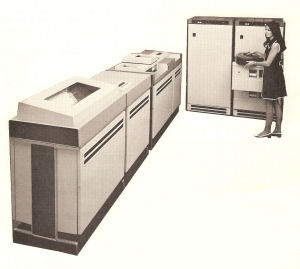|

The NCR Century 150 takes its place as the latest member of the existing family of powerful NCR Century series electronic data processing systems. Its design reflects and extends the common characteristics of NCR Century Computers: and extends the common characteristics of NCR Century Computers:
- Broad application to business requirements.
- Disc orientated for sophistication, compatibility and simplicity.
- Attractive cost/performance ratio.
- Uncomplicated programming.
- Compatibility through software with larger systems in the series.
The NCR Century 150, with its powerful new processor, provides the following capabilities:
- Mass Random Access Storage.
- Low cost communications ability.
- New technology — compactness and ease of maintenance.
- New Multi-port scanner — increases system throughput.
- High speed trunks — for fast peripherals.
- Smaller memory increments — the system can be tailored to meet specific requirements.
The NCR Century 150 provides a most flexible response to the information control and reporting needs of all small and medium sized business.
PERIPHERALS
The NCR Century 150 system includes the complete range of proven NCR Century peripherals:
- Industry compatible magnetic tapes units; high capacity disc units;
- CRAM (Card Random Access Memory); Card and paper tape readers and punches and high speed line printers.
TERMINALS
In addition to the conventional magnetic tape encoders, visual display units and teletype machines, NCR has introduced new Financial, Commercial and Retail Terminals for remote data processing.
SOFTWARE
Initial release of the NCR Century series provided 3 compilers: NEAT/3 COBOL and FORTRAN. Continuing development of both hardware and software has resulted in expanded versions of these compilers so that the full capabilities of these languages are now available on the NCR Century 150.
In addition, BASIC, an easy to learn, time-sharing language has been developed. BASIC provides multiple access facilities for remote terminals.
Two operating systems are available for use with the NCR Century 150. The Basic operating system which controls the computer on batch processing and the Dual Operating system which accommodates, concurrently, on-line and batch programming.
APPLIED SYSTEMS
NCR has developed a range of applied systems to facilitate fast and easy implementation of general purpose applications which, by their very nature, carry a degree of standardization.
These systems may be modified to meet individual requirements and to interface with specific tailor made applications to form a fully integrated suite of programs.
A major benefit to be derived from the adoption of these systems is an early return on capital investment and provision of more time in which to develop unique system requirements.
SUPPORT
NCR’s successful Selective Services Plan reduces financial commitments to the specific elements of support required by individual installations. Services offered, ranging from the provision of computer time for program development and testing to complete installation planning and implementation, have proved to be of great benefit to ‘first time’ computer users.
EDUCATION
A comprehensive education programme covering all aspects of data processing, from management techniques to operator training is available at our own Education Centre.
TECHNICAL SERVICE
NCR has achieved its high reputation not only in the design and manufacture of high quality data processing equipment, but also in establishing an effective technical service to ensure continuity of performance.
NCR’s policy to provide equipment designed for ease of maintenance by qualified technicians is extended to the NCR Century 150.
SYSTEM HARDWARE SPECIFICATION
Memory
Memory Sizes 24K 32K 48K 64K bytes.
Memory Speed 1 .2 microseconds per cycle.
Memory Access 2 bytes per cycle.
Technology Modular, plug-in High Density Core.
Arithmetic & Logic Unit
Commands: One orTwo-Operand, standard NCR Century format, with chaining and indexing.
Data: Data may be NCR Century Code (ISO standard), packed decimal or binary.
Command Set: 34 Standard and 3 Optional Commands provide for all Arithmetic, Logical, Control and Manipulative functions.
Technology: Compact packaging is achieved by use of Large Scale Integrated (LSI) Circuits.
Input/Output
INOUT Command: A single Command (INOUT) initiates all peripheral activities.
Trunks: One 5-way scanning trunk and one 8-position High Speed Trunk are standard. Two further 8-position trunks are available as an option.
Integrated Peripherals: Positions are provided for an integrated Card or Punched Tape Reader, Line Printer, Console and I/O Writer, and for an optional Communications Interface.
STANDARD PERIPHERALS
Input: Card Reader (300 CPM) or Punched Tape Reader (1000 CPS)
Output: Line Printer (600/1200 LPM)
Data Storage: Dual Spindle Disc Units (Max. 59.6M bytes per unit)
Operator’s Console: This includes either an Input Output writer at 6 character/sec. or Thermal I/O Writer at 30 character/ sec.
Communications: Max. 10 lines using integrated communications feature; 253 lines using freestanding unit.
|

